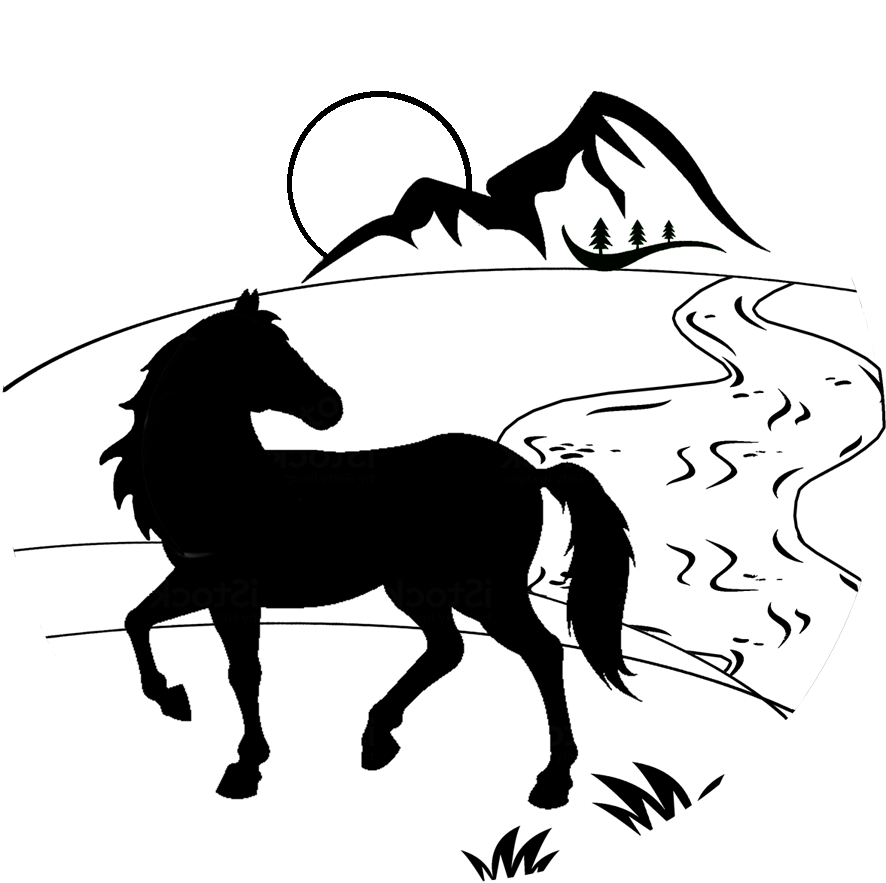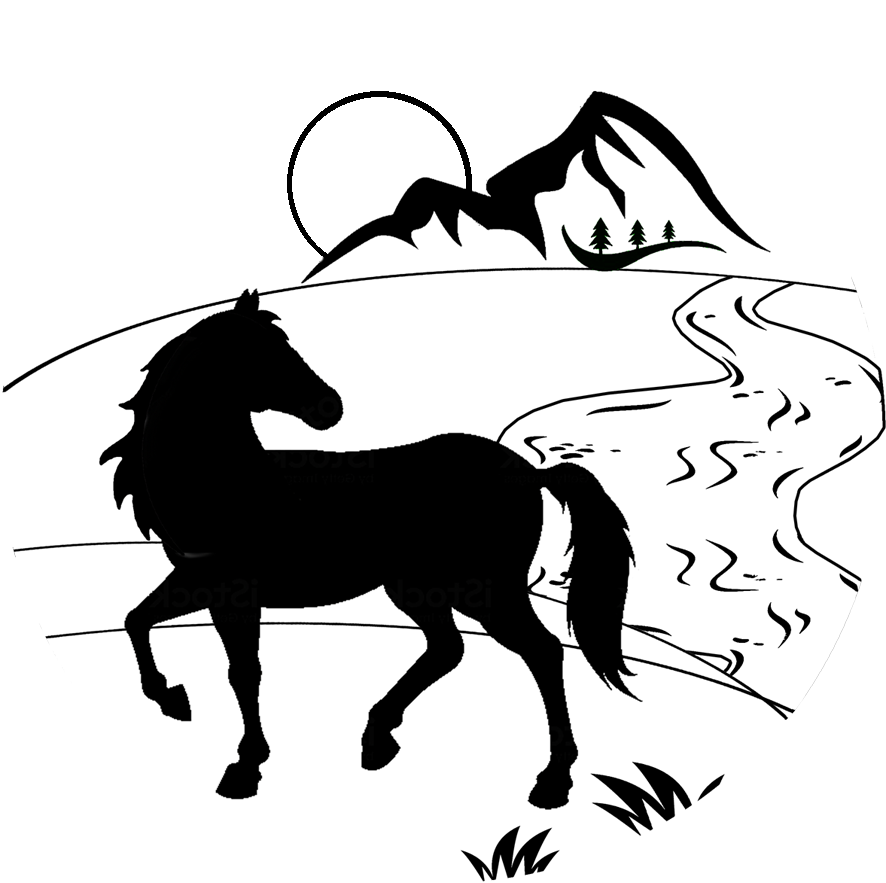YOU CAN WALK AROUND THE CENTER OF CITY. THERE ARE:
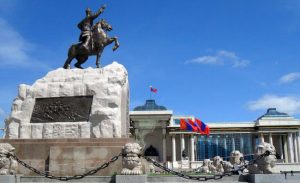 Sukhbaatar Square: is the central square of Mongolia’s capital Ulaanbaatar. The square was named for Mongolia’s revolutionary hero Damdin Sukhbaatar shortly after his death in 1923. The square’s name was changed to Chinggis square in 2013 in honor of Genghis Khan, considered the founding father of Mongolia. The center of the plaza features an equestrian statue of Damdin Sukhbaatar, while a large colonnade monument dedicated to Genghis khan, as well as Ogodei khan and khublai khan, dominates the square’s north face directly in front of the grey palace.
Sukhbaatar Square: is the central square of Mongolia’s capital Ulaanbaatar. The square was named for Mongolia’s revolutionary hero Damdin Sukhbaatar shortly after his death in 1923. The square’s name was changed to Chinggis square in 2013 in honor of Genghis Khan, considered the founding father of Mongolia. The center of the plaza features an equestrian statue of Damdin Sukhbaatar, while a large colonnade monument dedicated to Genghis khan, as well as Ogodei khan and khublai khan, dominates the square’s north face directly in front of the grey palace.
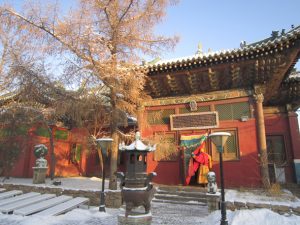 Gandan Monastery: is a Mongolian Buddhist monastery in the Ulaanbaatar. That has been restored and revitalized since 1990.The Tibetan name translate to the “ Great Place of Complete Joy”. It currently has over 150 monks in residence. It features a 26.5meter high statue of Avalokitesvara. The original statue, made of copper, was built after appeals to the Mongolian public, it was intent to restore the sight of the 8th Jebsundamba, also known as Bogd Khan. It features 2286 precious stones and is gilded with gold leaf.
Gandan Monastery: is a Mongolian Buddhist monastery in the Ulaanbaatar. That has been restored and revitalized since 1990.The Tibetan name translate to the “ Great Place of Complete Joy”. It currently has over 150 monks in residence. It features a 26.5meter high statue of Avalokitesvara. The original statue, made of copper, was built after appeals to the Mongolian public, it was intent to restore the sight of the 8th Jebsundamba, also known as Bogd Khan. It features 2286 precious stones and is gilded with gold leaf.
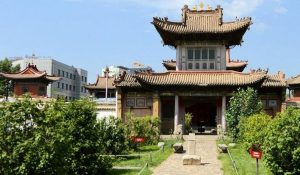 Choijin Lama Temple Museum: The complex consists of six temples originally occupied by the brother of the ruler the eighth Bogd Jetsun Damba khan, Choijin Lama Luvsankhaidav, who was the state oracle and ‘ Precious Wisdom and Clear Devotion’ Khutugtu at the time. The main temple features an 18th century gilt statue of Buddha Sakyamuni with a statue of Choijin Lama Luvsankhaidav on the buddha’s right and the embalmed corpse of Baldan Choephel on his left. In addition, of religious instruments, thanka paintings, silk embroideries, wood carvings, statues, and the biggest collection of tsam dance masks.
Choijin Lama Temple Museum: The complex consists of six temples originally occupied by the brother of the ruler the eighth Bogd Jetsun Damba khan, Choijin Lama Luvsankhaidav, who was the state oracle and ‘ Precious Wisdom and Clear Devotion’ Khutugtu at the time. The main temple features an 18th century gilt statue of Buddha Sakyamuni with a statue of Choijin Lama Luvsankhaidav on the buddha’s right and the embalmed corpse of Baldan Choephel on his left. In addition, of religious instruments, thanka paintings, silk embroideries, wood carvings, statues, and the biggest collection of tsam dance masks.
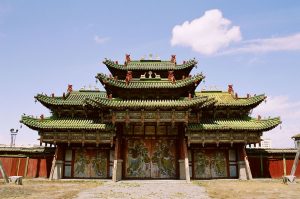 Winter Palace Bogd Khan: The winter palace of the Bogd khan or the museum is a museum complex located at the Green palace of the eighth Jebsundamba khutughtu, who was later proclaimed located Bogd Khan, or emperor of Mongolia. Alongside being the oldest museum, it is also considered as one of the museums with the biggest collection in Mongolia. The palace is the only one left from originally four residences of the Bogd Khan . Built between 1893 and 1903, the complex is one of the few Mongolian historical attractions which have neither been destroyed by the Soviets. With the winter palace, the gate of peace and happiness, the cooling pavilion as well as 6 temples, each containing Buddhist artwork, scripture and Thangka, such as Naidan temple and Makhranz temple, the palace complex consists of a total of about 20 structures. The museum has about 8600 exhibits and receives over 40000 visitors annually. On display are many of the Bogd Khan’s possessions, such as his throne and bed, his collection of art and stuffed animals, his ornate ceremonial Ger, a pair of ceremonial boots given to the khan by Russian Tsar Nicholas , and also a jeweled regalia worn by the Bogd Khan’s pet elephant.
Winter Palace Bogd Khan: The winter palace of the Bogd khan or the museum is a museum complex located at the Green palace of the eighth Jebsundamba khutughtu, who was later proclaimed located Bogd Khan, or emperor of Mongolia. Alongside being the oldest museum, it is also considered as one of the museums with the biggest collection in Mongolia. The palace is the only one left from originally four residences of the Bogd Khan . Built between 1893 and 1903, the complex is one of the few Mongolian historical attractions which have neither been destroyed by the Soviets. With the winter palace, the gate of peace and happiness, the cooling pavilion as well as 6 temples, each containing Buddhist artwork, scripture and Thangka, such as Naidan temple and Makhranz temple, the palace complex consists of a total of about 20 structures. The museum has about 8600 exhibits and receives over 40000 visitors annually. On display are many of the Bogd Khan’s possessions, such as his throne and bed, his collection of art and stuffed animals, his ornate ceremonial Ger, a pair of ceremonial boots given to the khan by Russian Tsar Nicholas , and also a jeweled regalia worn by the Bogd Khan’s pet elephant.
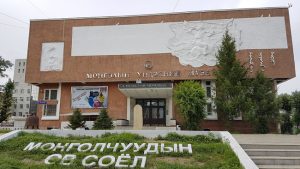 The National History Museum of Mongolia: is a cultural, scientific, and educational organization, which is responsible for the collection, conservation and interpretation of the objects under its curation. The first museum in Mongolia, the Mongolian National Museum was established in 1924 and became the basis for other museum, including the National Museum of Mongolian History. The modern National museum of Mongolian History was established after the merger of the historical, archaeological and ethnographical departments of the State Central Museum and the museum of the revolution in 1991.It is now located in a facility built for the museum of the Revolution, which was founded in 1971. Exhibitions cover prehistory, pre Mongol empire history, Mongol Empire, Mongolia during Qing rule, ethnography and traditional life, and twentieth century history. The ethnographic collection has significant displays of the traditional dress of various Mongolian ethnic groups and of snuff bottles. Most exhibits have labels in both Mongolian and English. The museum publishes one or more issues of its in house journal each year, with articles in Mongolian and foreign language, including Russian and English.
The National History Museum of Mongolia: is a cultural, scientific, and educational organization, which is responsible for the collection, conservation and interpretation of the objects under its curation. The first museum in Mongolia, the Mongolian National Museum was established in 1924 and became the basis for other museum, including the National Museum of Mongolian History. The modern National museum of Mongolian History was established after the merger of the historical, archaeological and ethnographical departments of the State Central Museum and the museum of the revolution in 1991.It is now located in a facility built for the museum of the Revolution, which was founded in 1971. Exhibitions cover prehistory, pre Mongol empire history, Mongol Empire, Mongolia during Qing rule, ethnography and traditional life, and twentieth century history. The ethnographic collection has significant displays of the traditional dress of various Mongolian ethnic groups and of snuff bottles. Most exhibits have labels in both Mongolian and English. The museum publishes one or more issues of its in house journal each year, with articles in Mongolian and foreign language, including Russian and English.
 The Zaisan Memorial Complex: is a memorial in the southern area of the Ulaanbaatar that honors allied Mongolian and Soviet soldiers killed in World War2. Located on a hill in the southern part of the city, the memorial features a circular memorial painting that depicts scenes of friendship between the people of the USSR and Mongolia. The mural depicts scenes such as Soviet support for Mongolian’s independence declaration in 1921, the defeat of the Japanese by the Soviets at Khalkh gol on the Mongolian border in 1939. There are a tank memorial, which took from Moscow in 1943 to its participation in the fall of Berlin in 1945.
The Zaisan Memorial Complex: is a memorial in the southern area of the Ulaanbaatar that honors allied Mongolian and Soviet soldiers killed in World War2. Located on a hill in the southern part of the city, the memorial features a circular memorial painting that depicts scenes of friendship between the people of the USSR and Mongolia. The mural depicts scenes such as Soviet support for Mongolian’s independence declaration in 1921, the defeat of the Japanese by the Soviets at Khalkh gol on the Mongolian border in 1939. There are a tank memorial, which took from Moscow in 1943 to its participation in the fall of Berlin in 1945.
